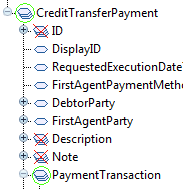Restructure limitations
If you use the data directly from the input document, data is read from the input document to memory by the automatic mapping. This means, you cannot modify the input data before it is restructured, neither apply logic on it in any other way. After the restructuring, you can modify the data in the mapping. But if you need to do modify the input data before it is restructured, use Collector functions.
These examples illustrate where you can use the Collector functions:
-
To substring a value so that all values have the same length to enable correct sorting and grouping, or if you need to group on only a part of the values.
One example is to sort and group on the date part of an element that contains date plus time.
-
To use the instance with a specific attribute value for a repeating data element that is not looped in the restructuring process.
Such as, to always use the main ID, or the English description.
-
To sort the value for either element
Aor elementB, depending on the value of another element.Then, you can create a mapping logic that assigns either element A, or element B, to an input parameter for a Collector function.
-
To sort the values from two input elements that are included within a choice as one value. That is, only one of the elements can exist at a time.
Then, you can create a mapping logic that assigns the element that is not null to an input parameter for a Collector function.
-
To convert a negative amount to a positive amount for correct summing.
-
To filter out data.
One example is to skip all transactions with a negative amount.
The current version does not support restructuring of parallel repeating elements or loops in the input document or in the Collector structure. You cannot restructure, for example, a repeating element for notes plus a repeating element for payment transactions, both per credit transfer payment, even if you only move the notes loop to the output document as it is. A future version can support this feature.

Follow these guidelines:
-
If you use data directly from the input document, then all loop levels must be given in the input document instance.
For example, if the complex element PaymentTransaction is not given for a CreditTransferPayment instance, then the CreditTransferPayment instance is not included in the restructured data.
-
If you use data from a nested Collector loop structure, then the inner loop must always iterate at least once.